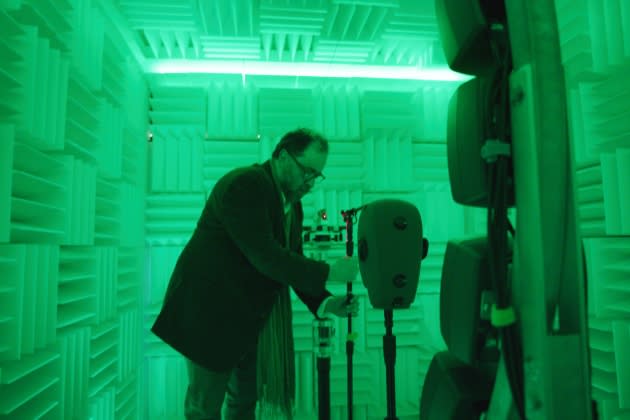’32 Sounds’ Is the Greatest Documentary You’ve Ever Heard

Sam Green wants you to stop and listen for a second. Like, really listen.
The Bay Area documentarian wants you take in the world around you, one curated noise at a time. It might be church bells, cicadas, wind chimes, or rushing currents. He may throw a few sonic curveballs your way as well — violins could quickly turn into explosions, or Philip Glass gently noodling on a piano might suddenly give way to the extremely loud buzzing of a fly. Occasionally, Green will ask you to close your eyes, the better to actually hear something; he’ll let whatever audio he’s picked play over a blank screen as a back-up plan. You don’t have to shut off your other senses. He just wants you to give priority to your ears for 90-plus minutes.
More from Rolling Stone
A Menudo Boy Bander's Disturbing Link to the Menendez Brothers
Syd Barrett Documentary 'Have You Got It Yet?' Shares First Trailer
Part aural history and part ASMR therapy session, 32 Sounds is Green’s attempt to chart what sound means to us — how it shapes our perceptions, what it stimulates in our memories, the way it can bridge the gap between the past and the present. There are stops along this essay film’s A/V tour: a montage of musicians performing John Cage’s “4’33”,” a symphony in which a single note is never played; Professor Edgar Choueri demonstrates the three-dimensional spatial aspects of recordings via customized headphones; a Foley artist named Joanna Fang explains why the art of making fake noises for movies “can elevate a truth over what’s really there.” (She also settles the issue about whether a tree falling in a forest makes a sound if no one’s around. The answer is “yes,” but only if you’ve got a wooden floor, some key FX items, and a well-miked studio.)
But more than anything, Green and his collaborator, Le Tigre’s multi-instrumentalist JD Samson, want to give you something immersive, that forces you to rethink something the majority of us take for granted on a daily basis. As a narrator, the director adopts a tone that’s whimsical but somehow never twee, and though Green has proven his chops as a straightforward documentary filmmaker — his 2002 profile of the Weather Underground is the definitive capsule history on the subject — this latest project is designed to be free-form, flowing, sensuous over sensationalistic. You might be asked to sing along with a Zen-like group of spiritual chanters. There will be a disco dance interlude.
It’s also treading over a lot of philosophical and emotional territory, however, and for every archivist or avant-garde artist weighing in on the science of it all, there are moments that sneak up and knock you sideways. A political radical living in exile in Cuba hears a snippet of McFadden & Whitehead’s “Ain’t No Stoppin’ Us Now” and is instantly transported to 1979 Harlem. The quiet of a rural, Upstate New York evening soundtracks a woman’s grief. The filmmaker’s old phone-message tapes become ghostly memorials, as well as a reminder of one truly immeasurable loss. It may be the only movie to ever turn a nearly extinct Moho braccatus bird’s mating call into something that could move you to tears.
When 32 Sounds made the festival rounds last year and did a week-long run at the BAM in Brooklyn, the duo would turn screenings into multimedia events, complete with headphones, live narration, and musical accompaniment. (It made our Best Documentary list last year, and the performance I saw at the San Francisco Film Festival remains one of the most blissful moviegoing experiences I’ve ever had.) Yet it works just as well as a collective viewing experience as it does a performance piece, and now that this playful and profound work is getting a proper release in theaters across the country, you owe it to yourself to seek this out. Green has given us something designed not to New-Age soothe so much as neurally stimulate, an exercise that rejiggers the notion of passive listening into active appreciation and attention. The sounds are finite, yet the benefits of tuning in to the film’s wavelengths are endless. It’s the greatest documentary you’ve ever heard.
Best of Rolling Stone

